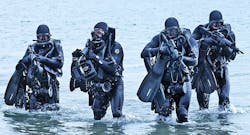Navy to brief industry this month on program to develop enabling special ops technologies
WASHINGTON, 9 June 2015. U.S. Navy leaders will brief industry later this month on an upcoming research project to develop new enabling special ops technologies for mine warfare; naval special warfare; expeditionary prepositioning and logistics; navy expeditionary combat.
Officials of the Naval Special Warfare program office in Washington will conduct the industry briefings in anticipation of an upcoming broad agency announcement (BAA_15-NR-6280) for the Confronting Expeditionary and Naval Special Warfare Capability Challenges project.
Navy leaders will ask industry for white papers that identify technologies that can enhance and accelerate expeditionary warfare and naval special warfare (NSW) capabilities for rapid insertion into a Navy program of record.
Navy experts particularly are interested in technologies that companies can develop and prototype over the next two years to Technology Readiness Level 7 -- or ready to demonstrate prototypes in operational environments.
Mine warfare involves technologies that can help detect and destroy enemy sea mines, or that can extend the endurance of off board sensor platforms.
Related: Wanted: special-ops battle suit with cooling, embedded computers, radios, and sensors
Naval special warfare involves technologies for multi-intelligence multi-spectral sensors that enhance situational awareness for manned and unmanned surface ships and submarines in shallow coastal waters or in harbors. Navy officials are interested in power and energy systems, daylight and night vision, and multi-sensor capabilities.
Expeditionary prepositioning and logistics involves packing technologies that reduces the volume of military equipment from the sea base to the individual user.
Navy expeditionary combat, meanwhile, involves technologies that improve the warfighter’s ability to attack targets, identify threats, solve complex problems, and adapt to situations faster than an adversary. Navy officials are interested in technologies that enhance the ability to operate in harbors, rivers, and that improve tactical multi-intelligence, surveillance, and reconnaissance (ISR) capabilities.
The solicitation for this program is expected by 24 July 2015 and will be open for one year.
Industry briefings on the Confronting Expeditionary and Naval Special Warfare Capability Challenges project will be from 9 a.m. to 1 p.m. on 25 June 2015 at Dell, 300 M St., suite 500, in Washington, D.C. Briefings are unclassified.
Those who would like to attend should register no later than 17 June 2015 by email to the Navy's Michael Dulong at [email protected].
Email questions or concerns the Navy's Brad Watson at [email protected], or Debra Mackall at [email protected].
More information is online at https://www.fbo.gov/spg/DON/NAVSEA/NAVSEAHQ/N00024-15-R-6280/listing.html.

John Keller | Editor
John Keller is editor-in-chief of Military & Aerospace Electronics magazine, which provides extensive coverage and analysis of enabling electronic and optoelectronic technologies in military, space, and commercial aviation applications. A member of the Military & Aerospace Electronics staff since the magazine's founding in 1989, Mr. Keller took over as chief editor in 1995.

